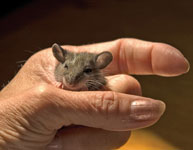Headliners: From housing to mousing
Headliners: From housing to mousing McGill University
User Tools (skip):
Headliners
From housing to mousing
Allergies in a nutshell

Clarke on allergies
Professor Ann Clarke, clinical immunologist, has been getting good ink with the publication of her study tracking exposure rates among children suffering from severe peanut allergies. As reported in Scientific American, Reuters News and MSNBC, 14 percent of the children in the study had ingested peanut allergens over the course of a year. While heightened public awareness and parental vigilance helped knock that number down from previoaus studies, the findings also showed children who did have moderate to severe reactions did not always receive the appropriate treatment. The study also suggested that while an increasing number of schools have become peanut-free, most of the accidental peanut ingestion happened at a friend's or relative's house.
Northern exposure

Friedman lends a hand
When it comes to architecture, Avi Friedman has an opinion — and he's not afraid to express it. In a recent article in the National Post, the co-founder and director of McGill's Affordable Homes Program sounded off about the proliferation of big, ugly two-car garages, calling them "an anti-social statement." His main complaint? These "snout houses," as urban planners,call them leave little room for front yards and porches and destroy the sense of community within a neighborhood.
The innovative architect popped up again in the Nunatsiaq News. The article highlighted the author and architecture professor's efforts to help municipal officials in Iqaluit plan a new housing complex for the city. The unique nature of the northern community requires Friedman to take into account such factors as added space for tenants' snowmobiles and komatik (sleds)...without adding two-sled garages.
Happy mice, better rat race

Is that mouse smiling?
iStock photo
Psychiatry professor Guy Debonnel hasn't built a better mousetrap but he has built a better mouse. The findings of his widely reported two-year study showed that mice genetically modified to be happy were almost incapable of being depressed, even when put in stressful situations.
These merry mice owe their enviable situation to the fact that they were bred without the Trek-1 gene, which controls the flow of serotonin, a chemical that affects everything from appetite to mood. Almost all antidepressants on the market regulate the flow of serotonin, but they are ineffective in about one-third of the population. Debonnel's findings offer hope to that one-third — as well as to everyone else suffering from depression.

